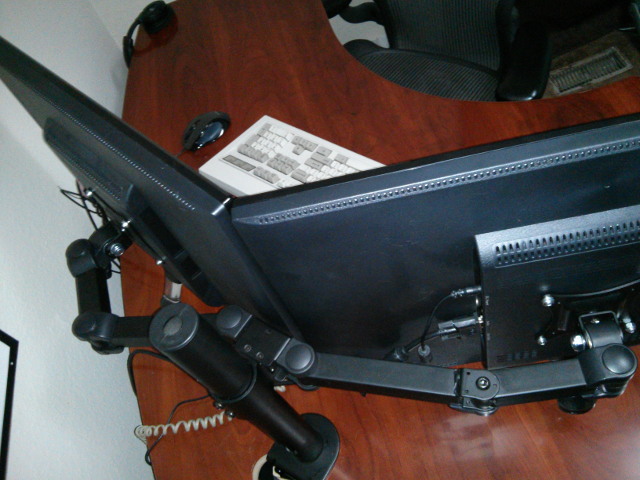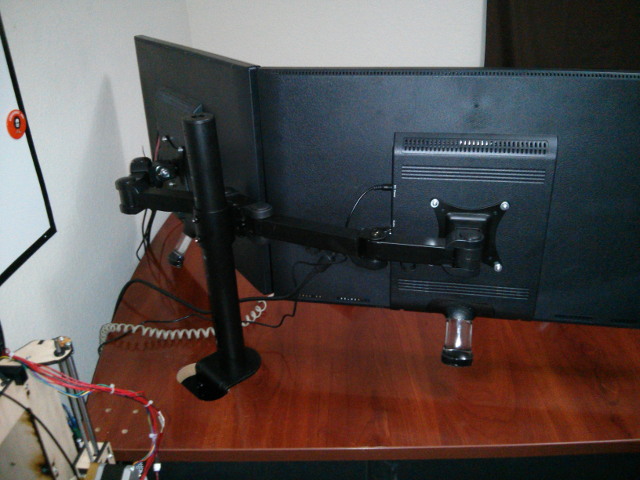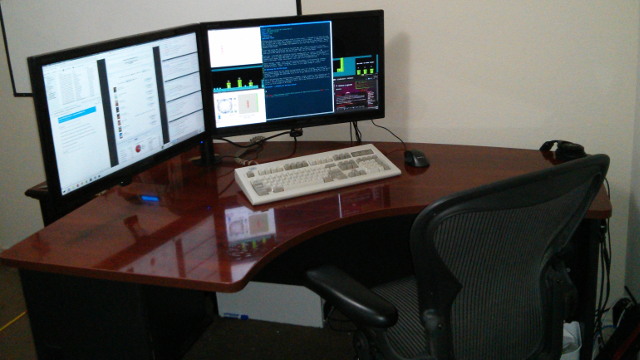I upgraded my monitors nine months ago. I replaced a pair of 21.5” 1080p TN LCD monitors with a beautiful pair of QNIX QX2710 27” 1440p IPS LCD monitors. These new monitors were too big for my old do-it-yourself LCD monitor stand. These monitors have tons of pixels and vibrant colors, but the quality of their built-in stands is very low. They are quite wobbly, and both monitors lean just a bit to the left.
I knew that building a replacement stand had to be a top priority. That was nine months ago, and in those nine months I didn’t make time to build a new monitor stand. Last month, I bought a 3D printer. I knew this would be a major time sink, and we already have so many other fun projects to work on, so I decided to just give in and buy a dual LCD monitor stand.
Why use a monitor stand or mount?
There are three reasons I like putting my monitors on a mount that is solidly attached to the desk. It significantly reduces the amount of desk surface the monitors physically occupy. The flimsy built-in stands on the QNIX QX2710 monitors are 10” by 6”. With the monitors hung on a mount, I can move things around underneath the monitors with no trouble.
Second, a good stand will let you adjust the height of the monitor. These monitors were much bigger than the ones they replaced, and their built-in stands had them sitting quite low. On those built-in stands, I sure felt like I was looking way down to see the bottom of the screen. I only raised the monitors about two inches higher using the new stand—any higher and the tops of the monitors will be above my head!
And most important of all, it keeps the two monitors from moving around in relation to each other. There is nothing that annoys me more than two monitors shifting, moving, or tilting, and I don’t like having a gap between the displays. That gap is almost impossible to eliminate without a monitor stand. Even if you manage to hide that gap, it will come back the first time you bump one of the monitors.
Choosing the “Mount-It!” articulating dual monitor stand
Picking out a dual monitor mount for a pair of 27” monitors was surprisingly difficult. There are plenty of stands that say two 27” monitors will fit, but I was more than a little apprehensive. I like to have my monitors angled towards each other at about 135 degrees. The arms don’t need to be as quite as long if you just want them to sit side by side with no angle.
I found all sorts of comments on Amazon telling me that their pair of 27” monitors fit on the stand, but none of them mentioned anything about angles. This worried me a bit, but I figured I would give it a try anyway.
The good news is that you can definitely arrange a pair of 27” monitors at a 135-degree angle (or 45-degree depending on how you’re measuring). The only problem is that things are pretty tight. I was hoping to attach this arm to the rear edge of the desk, but the arms just aren’t long enough. If you want to arrange the monitors at an angle, then you’ll have to sit almost directly perpendicular to the mount.



I figured this might be problematic before I placed my order, and I knew exactly what I would do if this happened. I put the clamp right through the grommet hole on my desk. This worked surprisingly well, and I was able to position my monitors almost exactly where they were before.
Using your brain
I wasn’t using my brain while I was ordering this stand. After I had this dual monitor mount all set up, I figured out what I could have done. I should have bought a triple monitor stand instead. They come with an extra fixed mount in the center, and their two arms look like they’re quite a bit longer. The triple monitor stands are too wide for a pair of 27” monitors. My friend Brian tried, and the arms just wouldn’t bend far enough to get the monitors to touch. They were almost 3” apart!
I found some diagrams of my dual monitor stand and the triple monitor stand in some auction listings on eBay. If they can be trusted, and I did my metric conversions correctly, then each arm should be about three inches longer on the triple monitor mount. That extra six inches would have added a lot of flexibility in the placement of the stand.
A mount by any other name is probably the same mount
There are at least half a dozen identical monitor stands on Amazon sold under different brand names. They all look the same to me, and the packaging mine came in was completely generic. My method for choosing a brand was very simple: I picked the cheapest one with Amazon Prime shipping. I couldn’t think of a good reason not to choose the least expensive of the identical stands.
All of these seem to be the same mount:
- Mount-It! Articulating Dual Arm Monitor Desk Mount — I bought this one
- SIIG Desk Mount for 13 to 27 Inches Dual Monitor
- Pwr+ Dual Ergonomic LCD Monitor Mount
- Dual LCD Monitor Desk Mount Stand by VIVO
Build quality
I don’t really have much to complain about here. The entire thing seems to be made of steel. The vertical support is nearly two inches in diameter, and the arms are one-inch square tubes. All the welds look pretty good to me.
There were a lot of complaints on Amazon about how loose all the joints on this monitor stand are. They aren’t exactly wrong. All the joints were pretty easy to move when it arrived, and the monitors would immediately droop down.
There is an Allen bolt at each joint on the arms, and there is a big nut to adjust the tilt tension of each monitor. You have to torque those tilt tensioning nuts down REALLY tight. Don’t be afraid to crank down on them pretty good.
I wanted to make absolutely certain they wouldn’t drift on their own. Once you torque them down tight enough, the monitor will tilt when you turn your wrench. I ended up sticking a long screwdriver between the mounting bracket and the hinge to use as a pry bar to keep the monitor from tilting. I probably tightened it down an extra quarter of a turn that way. It isn’t going anywhere.
Mounting the monitors is a little tricky
There is a somewhat nicer-looking articulating monitor stand sold by Monoprice. Their stand has a removable bracket. You bolt the bracket to the monitor and then just drop the monitor onto the stand. Unfortunately for us, Monoprice says their stand is only big enough for 24” monitors. The stand from Monoprice doesn’t look as sturdy as the “Mount-It!” stand.
The stand I bought does not have this handy feature. You have to hold the monitor up with one hand and put the screws in with the other. These monitors only weight about 12 pounds, so this wasn’t all that difficult. I did have to move the desk out from the wall and do some minor gymnastics to get the second monitor up, but even that wasn’t too bad.
Washers to the rescue!
The stand came with two different sets of metric M4 screws for attaching the monitors. The short set of 12 mm screws are a little too long for the QNIX QX2710. I had to put three or four washers on every screw to take up the slack. This isn’t ideal, but it is working for now. I’m sure I’ll remember to pick up some 8 mm screws on a random trip to Home Depot. This is fine in the interim.
I have no room to test monitor rotation
The “Mount-It!” monitor mount allows you to rotate each monitor. This lets you switch from landscape to portrait and back again. I don’t have nearly enough clearance to spin these monitors at the height I’ve chosen for them. They’d just bang off the desk if I try.
I have had to rotate each monitor a hair to get them to line up, though, and it seems to work just fine.
Should I debezel these monitors? Absolutely!
You might notice in the pictures that my monitors have half of the built-in stand hanging down in the back. This is because they are a permanent part of the case. The only way to remove them is to crack the entire case open.
I plan on removing them, but once those shells come off, there is no way I’m going to put them back on. Debezeling the QX2710 looks pretty simple. You just have to attach the box containing the electronics to the back of the screen.
Debezeling a pair of QX2710 monitors will be slightly more complicated. The VESA mounts are built into that box that has to be glued to the screen. I have to be very careful if I want these monitors to line up evenly on the dual monitor mount. I have to make sure those boxes are perfectly level and they need to be at the same position on both monitors.
I don’t think it will be much of a problem, but I will have to survive without monitors while the glue dries. The debezeled QX2710 monitors look very nice when painted a matte black, but there is no way that I have enough patience to wait for the paint to dry!
Cable management
I haven’t rerouted my cables yet, because I know I will be tearing this all down when I remove the bezels from these monitors. I also have a feeling that these DVI cables might be a bit short if I route them through this stand’s built-in cable management.
There is a big hole in the back of the main support pole right where it meets the clamp. To make use of that, you have to run the cables up to the top of the pipe and drop them down the tube.
I’m not sure how impressed I am with this solution. It will definitely hide the cables from my view, but I think it will look pretty silly from behind. We’ll see what happens when I get to that point.
I thought I had a brilliant idea, but I was mistaken
On Friday night, I thought I had a great idea. It looked like I could move the monitor mount out of my desk’s grommet hole and still get the monitors in precisely the position that I want them. My trusty tape measure agreed with me. All I had to do was move the 8” segment from one arm to the other. That would easily allow one monitor to extend way out from the back of the desk.
Removing a segment and reconfiguring the arms was a piece of cake. Unmounting and remounting monitors on their VESA mounts took some more juggling and gymnastics. I get everything put back together, and the monitors had no trouble reaching the positions I was aiming for. There was one huge problem.
The longer arm was sagging over ¼” lower than the shorter arm. This looked very silly, and I couldn’t think of a good way to correct for it. I had to go back through all of the juggling one more time, and I am right back where I started.
I should have anticipated this. I learned during the very first iteration of my do-it-yourself monitor stand that sagging is an issue. I learned pretty quickly that trying to make the monitors level was nearly impossible. Forget level. Straight and even in relation it each other is about the best you’ll ever get.
Even when you’re working with heavy-duty steel pipes or tubing, you’re still going to have a bit of flex. Just one degree is very noticeable over a distance of one or two feet!
The verdict
I think I made a good choice. This stand is definitely roomy enough if you have an average desk. I have a large, almost L-shaped corner desk, and I face my chair almost directly at that corner. That corner is almost 40” away from the “front” of the desk. Unless you are in my situation, the “Mount-It!” dual monitor stand should work just fine, but the cost to upgrade to the bigger triple monitor stand is very reasonable.
It is doing a fine job holding up my QNIX monitors, and it should work just as well with any other 27” 1440p monitor, like the X-Star DP2710, the Yamakasi Catleap, or the ASUS PB278Q.
- Mount-It! Articulating Dual Arm Monitor Desk Mount — I bought this one